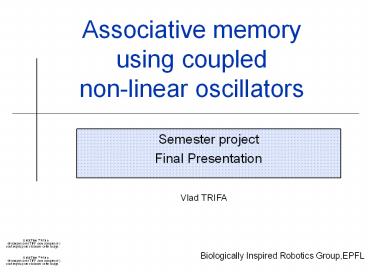Associative memory using coupled non-linear oscillators - PowerPoint PPT Presentation
Title: Associative memory using coupled non-linear oscillators
1
Associative memory using coupled non-linear
oscillators
- Semester project
- Final Presentation
Vlad TRIFA
2
Project summary
- Litterature review
- Implementation of an associative memory using
coupled oscillators and analysis of
performance/drawbacks. - Mixture with the BIRG model
- Generalization to complex signals
- Better control on the capacity
- Final discussion about relevant issues concerning
the performances of both models - Conclusion
3
Associative Memory
- Animal and human memory works by association.
- Able to retrieve a stored pattern upon
presentation of a partial and noisy
representation of an input signal. - Many models developed since early 80s
- Concepts taken from statisic mechanics and
hebbian learning rule turned neural networks into
dynamic systems. - Useful into understanding dynamics of networks
(emergence) - but
- Lack of biologically plausible mechanisms
(coupling, binary,) - Low capacity and performance (Global coupling N2
parameters)
4
Oscillators
- Oscillating systems are very common in nature
and possess very intersting properties. - Synchronization
- Energy efficient mechanism for temporal
correlation - Many brain processes rely on interaction of
oscillators - CPG
- Olfactory and visual cortex
- Temporal correlation hypothesis and binding
problem - Information can be stored as phase relationships
patterns, where coupled oscillators converge.
5
Analyzed model
- Can be found in Borisyuk, 2001.
- Oscillators described by phase, amplitude, and
frequency.
6
The model
7
(No Transcript)
8
Dynamics
9
Model performance
- The capacity of this model is not easy to derive,
due to the random phase shifts, and to the
dynamics of the nonlinear term - We do not know what percentage of overlapping is
possible, as memorized patterns can be
overwritten. - Implies that error increases as memory is filled.
- Robustness due to distributed memorization.
- But, loss of groups influence strongly the
retrieval error.
10
Discussion
- The model is interesting as it is based on
oscillating systems, thus can be easily
implementable on many oscillating systems (PLL,
etc). - A very nice methodology that is embedded in the
system is proposed in order to decide where to
store an input signal is proposed. - Random phase shifts ensure some robustness to the
system, but too big influence on the performance.
11
Drawbacks
- The all-to-all coupling into groups is not
efficient computationally and it uses too many
oscillators. - Due to the explicit input signal embedded in the
equations, we can only learn sine functions. - The input dimension is annoying. Complexity is
increased with no performance increase. - The time is reset after each stimulus. We need to
present the input in-phase with the oscillators.
We cannot learn sequences.
12
Improvements
- We want to be able to learn complex signals.
- Starting from the model in Righetti et al,
2005, we want to extend the model to form a
network.
13
(No Transcript)
14
(No Transcript)
15
(No Transcript)
16
(No Transcript)
17
(No Transcript)
18
(No Transcript)
19
(No Transcript)
20
(No Transcript)
21
(No Transcript)
22
Discussion
- Simpler model, more computationally efficient.
- We gained a much better control on the amount of
oscillators to dedicate for a frequency
component. - We are able to memorize complex signals in a
robust and fault tolerant manner, under some
constraints. - but
- Unfortunately, the capacity depends on the
complexity of the signals to store. - We lost the selection of the storage sites based
on phase relationships we had with the previous
model.
23
Future work
- We need to find a mechanism (embedded in the
dynamics) that can select where each component
should be stored depending on the signal. - It would be very intersting to create links
between different clusters activated by the same
signal, similar to associative connections
forming according to the correlation of neural
activity between assemblies, enhancing robustness
if attenuated components. - Reduce parameters, so we need only to select the
amount of oscillators allocated per component.
24
Conclusion
- This work should be considered as an attempt to
provide insights on how it is possible to store
information encoded as a complex signals in a
reliable manner, simply by using oscillating
systems with local interactions. - Our approach is interesting as it uses some
concepts that are common in biological neuronal
networks such as - Oscillating components with local interactions
- No global external process to supervise the
learning procedure
25
Thank you!
- References
- Borisyuk, 2001
- Righetti et al., 2005
- Singer, 1995































